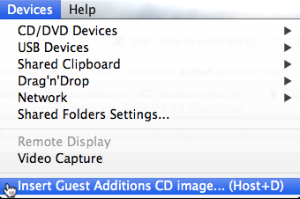...
Install Guest Additions
| Warning |
|---|
It is very important that the version of the Guest Additions installed on the virtual machine matches the version of the VirtualBox application. If Problems have been found if they are not the same, shared folders & screen resizing may not work correctly, even if a version of Guest Additions is installed. In which case, re-install following the instructions below. Experience may vary, using more recent versions of Guest Additions may work. |
To install or re-install Guest Additions follow these instructions.
...
To check if guest additions is already installed run the following command in a Terminal:
| Code Block | ||
|---|---|---|
| ||
lsmod | grep -i vbox |
...
| Code Block |
|---|
vboxsf 47936 0 vboxvideo 12669 1 vboxguest 293037 6 vboxsf drm 335594 3 vboxvideo |
Remove the Guest Additions packages by using the following command in a Terminal:
| Code Block |
|---|
sudo zypper rm virtualbox-guest-x11 virtualbox-guest-tools |
Reboot then re-install However, if shared folders and automatic resizing of the screen are not working, then try re-installing following the instructions below.
...
- Start up the virtual machine (VM) and let it start up fully.
First check that the necessary kernel files are installed:
Code Block zypper search kernel-devel
If not, install them with the command:
Code Block sudo zypper install kernel-devel
The installation needs to be done as the root user. This command will prompt for the root password '
metv1ew!'- With the VM virtual machine as the active window, select the 'Devices' menu and the 'Install guest additions CD image..
A popup window should appear in the virtual machine showing the CD. - In the virtual machine, open a Terminal window from the openSUSE icon and 'Applications' menu
In the Terminal, change to the directory where the VBoxAdditions CD was mounted. This will be under the /run/media directory, followed by the username.
Code Block title e.g. cd /run/media/openifs/VBOXADDITIONS_4.3.34_104062
To start the installation of the Guest Additions, type the following command into in the Terminal:
Code Block sudo ./VBoxLinuxAdditions.run
This will prompt for the root password, usually
'metv1ew!'Info The installation may report that Guest Additions is already installed and ask you to confirm.
The installation only takes a few minutes.
- Reboot the virtual machine for the changes to take effect.
Allow normal users access to shared folders
Check that the user accounts have access to the shared folder. The shared folder is usually mounted in the /media directory:
| Code Block |
|---|
% ls -l /media
drwxrwx--- 1 root vboxsf 170 Jun 2 2014 sf_shared_folder |
In the above example, the VirtualBox settings have used a shared folder name of 'shared_folder'.
For users to read/write to this directory, they must be in the 'vboxsf' group. Look in the /etc/group file to check:
| Code Block |
|---|
% grep vboxsf /etc/group
vboxsf:x:493:openifs,metview |
If the usernames are missing, add them using these commands:
| Code Block |
|---|
sudo usermod -a -G vboxsf openifs
sudo usermod -a -G vboxsf metview |
The user will need to log out then back in again for this change to take effect.
| Info |
|---|
Please note that the user 'openifs' does not exist on the earlier OpenIFS Virtual Machines. |


